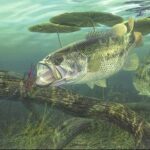Fishing, like many other hobbies, has its own vocabulary of words. This article will address come of the more common fishing terms that aren’t obvious to get you started. Synonyms commonly used for these fishing terms will be listed also.
Bait is a fishing term that seems obvious, but it is often confused with lure. A good basic definition to tell the difference between the two is that bait is food and a lure looks like food. Real worms are bait and artificial worms are lures.
A bobber, bobbler, or float is a device attached to the line that holds bait (generally) suspended in the water. They are usually made of brightly colored plastic. Please don’t say bobbler.
Freshwater fish is a term that simply refers to fish that live in fresh (non-salt) water. Saltwater fish live in the ocean.
While fish have a variety of names and nicknames that are too extensive to list here, here are some common terms used for three of the most popular fish. A largemouth bass is often referred to as a bucketmouth or big mouth bass. Smallmouth bass are often referred to as smallies, bronzeback or simply bronze. Bluegill are often called bream or sunfish.
Structure is another fishing term that you will hear a lot. Structure generally refers to things in the water. Examples are rocks, trees, docks, etc. Also natural changes in the water such as deep holes, riffles, etc. can be considered structure.
Worms are another source of confusion at times. Night crawlers are the most common type of worm sold as bait. They are a bit larger than the standard garden worm you might find in your backyard. Other common baits are meal worms (small little creature sold commonly as bait), minnows (small fish or young fish), and chicken livers (yes, chicken liver).
If someone states that caught a hawg or hog, it means that they caught a big fish. Stories about big fish are also referred to as ‘Lies’.
Catch and release is simply that. You catch the fish, take out the hook, and put it back in the water.
A jig is simply a hook with a lead weight attached on the shank, near the eye. The shank is the straight part of the hook and the eye is where the line ties on. A barb is a small second point inside the hook. It is designed to hold both bait and the fish onto the hook. Barbless hooks are often required in catch and release areas. Some hooks have extra barbs on the shank to also hold bait. Treble hooks are simply hooks with three points.
Any beginning fisherman should get a basic fishing book or borrow one from the library to become familiar with fishing terms and techniques. Order a free fishing catalog online from a major supplier (Cabela’s, Bass Pro Shops, etc.) to get more information on products available. But keep this in mind, fish don’t get caught by fancy words or equipment. If that was true the Indians would have starved.



